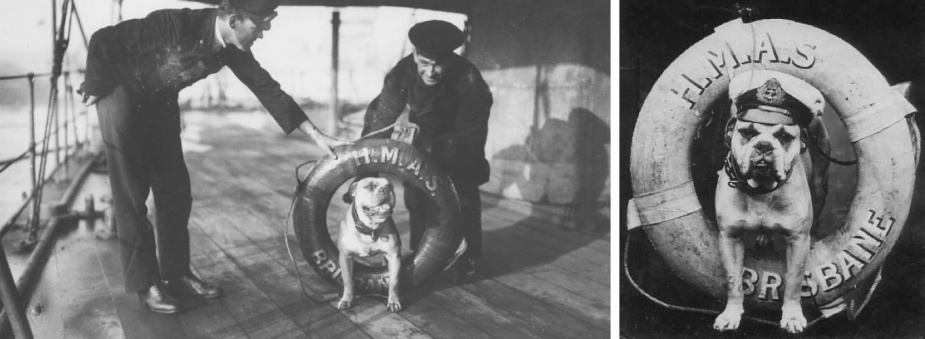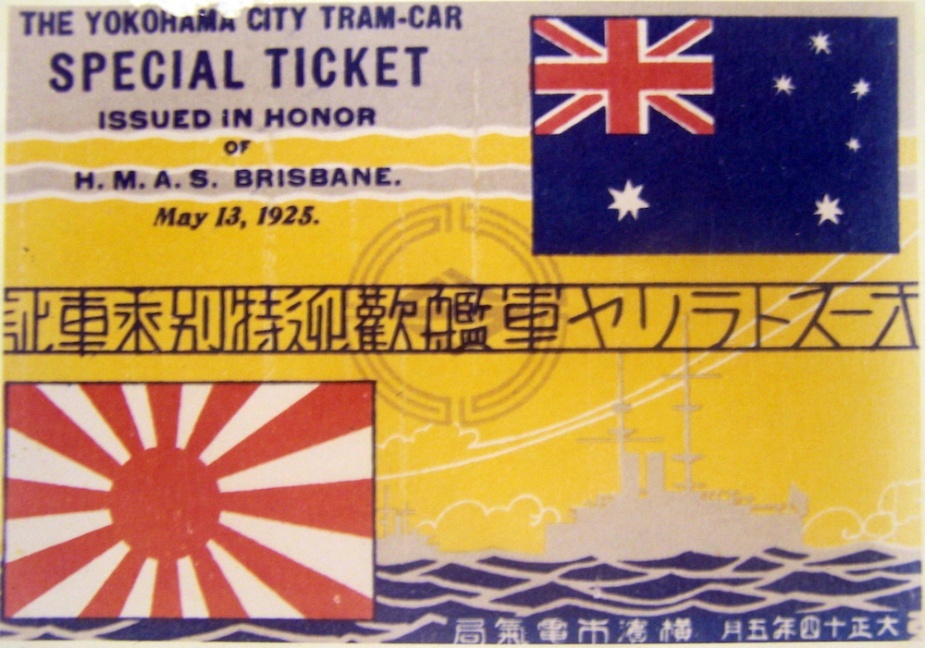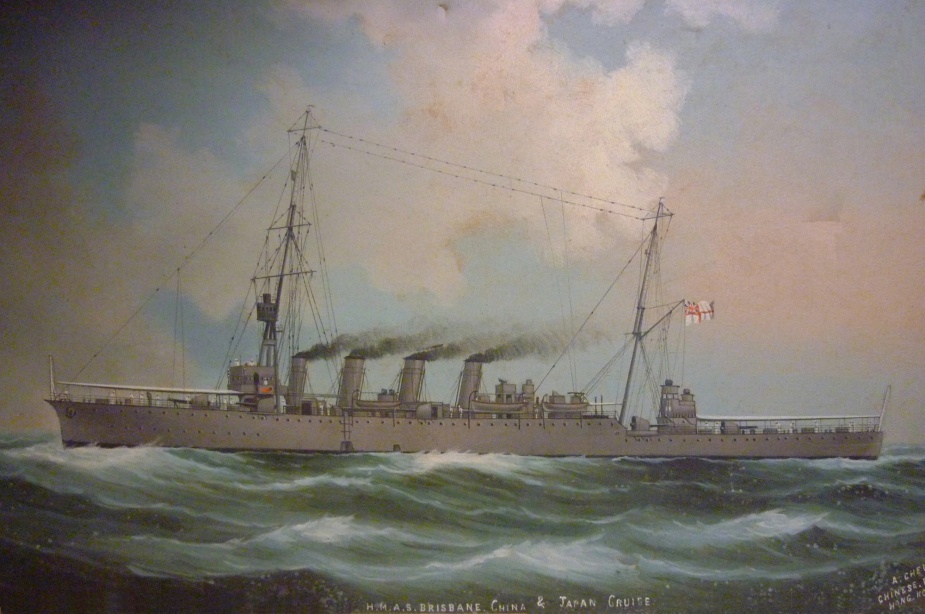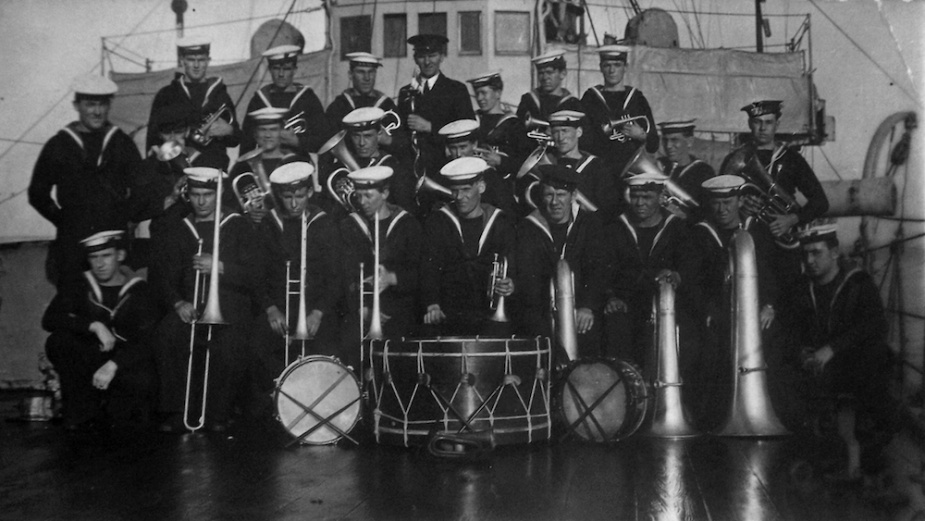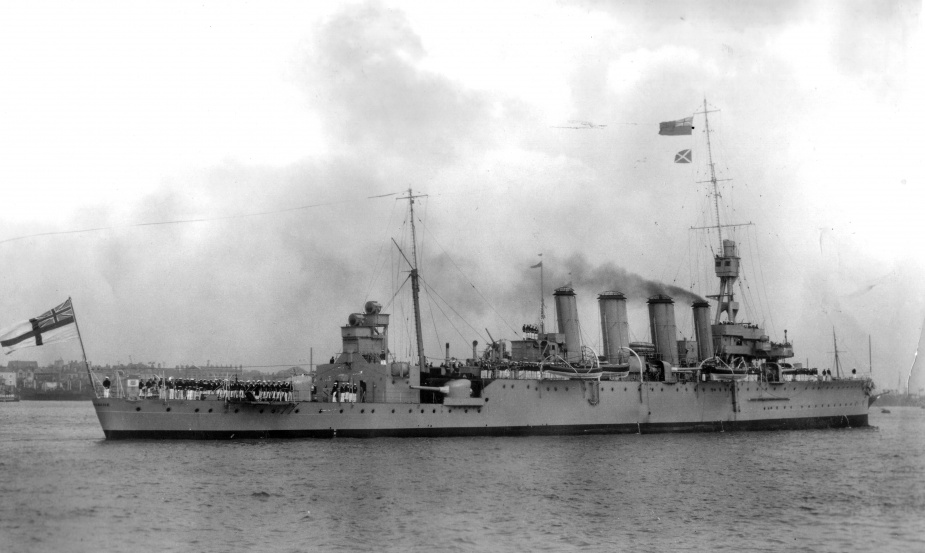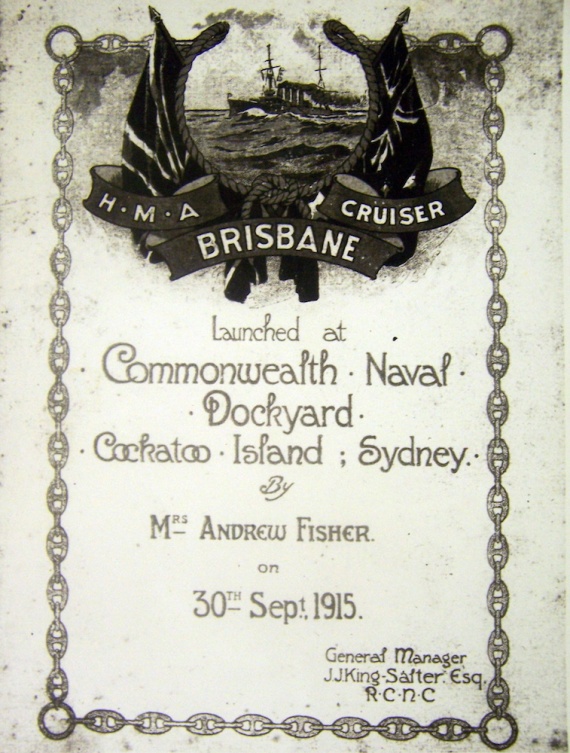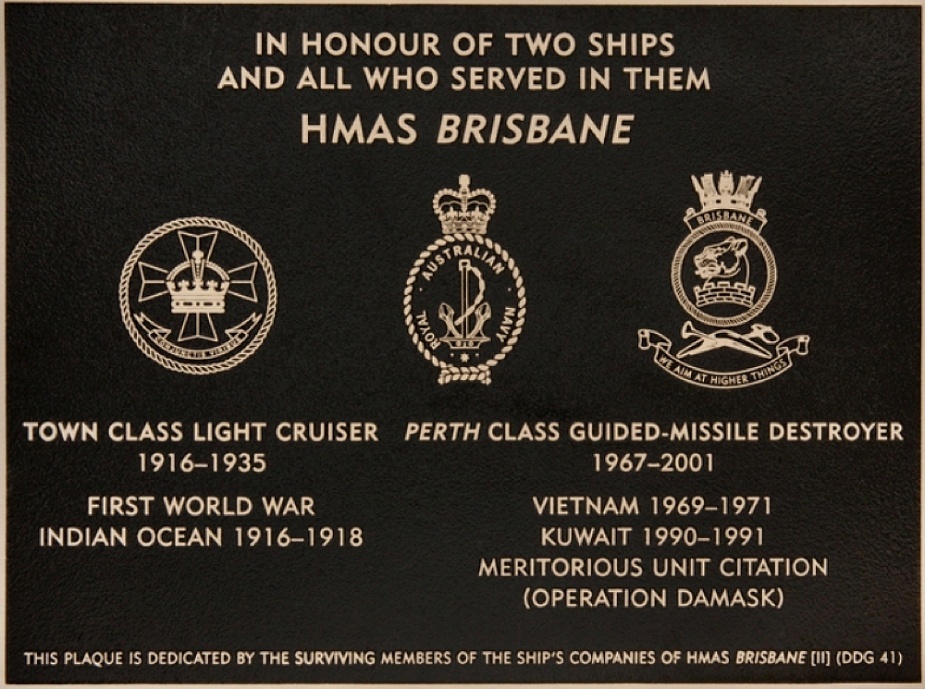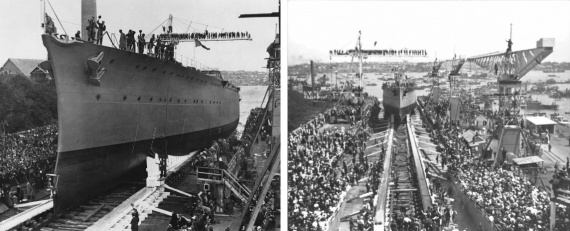
HMAS Brisbane and her sister ships HMA Ships Melbourne and Sydney were the first cruisers built for the RAN. They were constructed to the design of the Chatham group of the British Town Class.
Brisbane was launched on 30 September 1915 by Mrs Fisher, the wife of the then Prime Minister Andrew Fisher. Brisbane commissioned at Sydney on 31 October 1916 under the command of Captain Claude L Cumberlege RN. Several members of her ship"s company came from the recently decommissioned light cruiser HMAS Pioneer which had recently returned to Australia after two year service in German East Africa.
On 13 December 1916 she departed Sydney for war service in the Mediterranean, arriving at Malta on 4 February 1917. Here she was docked for two months to receive upgrades to her equipment, that were not available when she was built in Australia, and also allegedly to make good some poor workmanship from her build at Cockatoo Island. After leaving dock Brisbane was transferred to the Indian Ocean to assist in the hunt for the German commerce raider SMS Wolf which was known to be active in this area. While in port at Colombo (Ceylon) in April 1917 a Sopwith Baby seaplane, from the seaplane carrier HMS Raven (II), was transferred to Brisbane to assist in her search for the Wolf . This was the RAN"s first involvement in naval aviation but when the cruiser was ordered back to Australia, in June 1917, the ship unfortunately had to give up the aircraft. She then operated on patrol duty off the Western Australian coast until late September.
Between October 1917 and January 1918 Brisbane served on patrol duty in the western Pacific, visiting the Solomon Islands, Nauru, Ocean Island, Tarawa (Gilbert Group) and Fiji. This was as a result of concerns that the German raiders Wolf and SMS Seeadler were still active in the Pacific. Seeadler had actually been been wrecked on Mopelia Atoll in early August 1917 and Wolf was on her way back to Germany but this information was not known for several months. From February to October 1918 Brisbane served in Australian waters on patrol duties due to the fear that more German raiders would be sent to the Pacific Ocean.
On 21 October 1918 Brisbane departed Sydney for England and was at sea en route from Colombo to Aden when the Armistice of 11 November 1918 ended hostilities in World War I. She reached Mudros, on Lemnos Island, on 26 November 1918 and spent a month operating with the Australian Destroyer Flotilla in the Eastern Mediterranean. Sadly two of her sailors (Stoker 2nd Class JF Godier and Able Seaman TJ Chitts) died from Spanish influenza on 2 December 1918 and were buried ashore at East Mudros Military Cemetery. Brisbane sailed through the Dardanelles, to the Sea of Marmara, and then entered the Black Sea where she became part of British force that operated off Sebastopol and Smyrna; as a show of force to support White Russian forces engaged in fighting the Bolsheviks. In early 1919, Brisbane steamed to England and in late January commenced a refit, at Portsmouth dockyard which lasted three months.
Captain Walter Thring, RAN took command of Brisbane on 7 April 1919 and she sailed from Portsmouth for Australia on 17 April, via Malta, Port Said, Aden, Colombo, Singapore and Darwin. Earlier in the year the British Admiralty had presented to Australia six J-Class submarines. Escorted by the light cruiser HMAS Sydney and the submarine depot ship HMAS Platypus, the submarines had left Portsmouth for Australia earlier in the month. Later Sydney detached en route and Brisbane assumed responsibility for the escort of HMA Submarine J5 and towed her for some of the voyage to Sydney. Proceeding ahead of Platypus and the other submarines, Brisbane and J5 arrived at Sydney on 27 June 1919. Captain George Hyde, RAN assumed command of the ship on 27 August 1919.
Brisbane served mainly in Australian waters for the next three years and at one stage was being considered as the ship to embark a Fairey III sea plane for naval aviation trials; but this did not eventuate. In March 1921 she had visited Singapore flying the flag of Rear Admiral Sir Percy Grant KCVO, CB, RN, First Naval Member, who for the purposes of attending a naval defence conference had been temporarily appointed as Commander-in-Chief, Australian Naval Station. Captain John Stevenson, RN became the cruiser"s Commanding Officer on 11 October 1921 and she paid off into Reserve, at Sydney, on 4 August 1922.
On 14 April 1923 Brisbane recommissioned at Sydney under the command of Captain Henry Feakes, RAN who in turn handed over command of the cruiser to Captain Ralph Sneyd, DSO, RN on 22 August 1924.
Brisbane served mainly in Australian waters until February 1925 when, in company with Sydney, she again visited Singapore in connection with a naval conference. On that occasion Rear Admiral PH Hall-Thompson CB, CMG, RN, First Naval Member, was temporarily appointed as Commander-in-Chief, Australian Naval Station, as Sir Percy Grant had been in 1921. Rear Admiral Hall-Thompson hoisted his flag in Sydney.
From February to August 1925 Brisbane served on exchange duty in the Far East with the China Squadron of the Royal Navy. HMS Concord replaced her on the Australia Station. Brisbane became part of the 5th cruiser squadron and conducted showing the flag visits to Port Swettenham (now Port Klang) in Malaya, Hong Kong (twice), Wei Hai Wei (China) and Yokohama which was the first visit by an RAN ship to Japan. During her visit to Port Swettenham a swarm of bees descended upon the ship and Captain Sneyd sent a signal to the senior Royal Navy ship in port (HMS Hawkins) that Brisbane was temporarily out of service until the bees could be cleared from the ship. The senior officer in Hawkins was entertaining several British expatriates and their wives at the time and thought it funny to send a signal to Sneyd asking "How man Bs in Brisbane? to which Sneyd replied "How many Haws in Hawkins!" Captain Sneyd handed over command of the cruiser to Captain Julian Patterson, OBE, RN on 1 May 1925. In the later part of her service on the China Station, Brisbane was sent to Hong Kong to help restore order during a general strike. Her ship"s company assisted the local authorities to disperse large crowds and also her stokers kept the coal fired power station operating. On 18 July, while the cruiser was at Hong Kong, there was a major landslide in the Po Hing Fong district which destroyed many homes and killed 73 people. Warrant Officer Shipwright Robert Cargin from Brisbane was ashore at the time visiting friends and took part in the rescue operations; he was later awarded the Bronze Lifesaving Medal of the Venerable Order of St John of Jerusalem for "conspicuous gallantry for saving life at imminent personal risk in connection with the Po Hing Fong disaster at Hong Kong". Brisbane returned to Australia on 30 August, via Tarakan (Borneo) and Thursday Island, and was decommissioned on 7 October 1925. Many of her crew were transferred to her sister ship HMAS Melbourne which was due to proceed to England on exchange service with the Royal Navy.
On completion of a short refit Brisbane recommissioned at Sydney on 17 November 1925, under the command of Commander George Langford, RAN as a training ship and in this role the ship was based at Flinders Naval Depot (HMAS Cerberus) in Victoria. She paid off again at Sydney on 30 October 1926 to undergo a longer refit and recommissioned for training duties on 28 June 1928 under the command of Captain Gerald Harrison, RN. This was to be only a brief period of service and Brisbane served mainly in Australian waters, although in August 1928 she visited Honolulu to take part in the sesquicentennial celebrations of the discovery of the Sandwich Islands (Hawaiian Islands) by Captain James Cook RN. One of her sailors recalled trying to explain to a US Navy sailor why an Australian ship was involved in a British commemoration. On her return journey to Australia she called in at Suva (Fiji) and then operated off the east coast of Australia for the remainder of the year.
Brisbane decommissioned again on 22 January 1929 and then on 16 August 1929 Brisbane was placed in C-Class Reserve and then finally on 1 December 1930 she paid off into E-Class Reserve. As she was still a relatively new ship, with only 13 years of service, she was retained in reserve, although the RAN did not have the money or manpower to reactivate her during the period of the Great Depression.
Brisbane was recommissioned at Sydney on 2 April 1935, under the command of Captain Charles Farquhar-Smith, RAN and on 2 May 1935 she sailed for England manned by a complement which would form the balance of the ship"s company of the new HMAS Sydney (ex-HMS Phaeton), a Modified Leander-class light cruiser. While en route Brisbane assisted the sloop HMS Hastings, on 13 June, which had run aground on Shab Kuttle Reef in the Red Sea. The ship arrived at Portsmouth on 12 July 1935, where she finally paid off on 24 September 1935.
In June 1936 Brisbane was sold for breaking up to Thomas Ward & Co Ltd of Sheffield, England, for £19,125.
Specifications
 |
| Class |
Town Class |
|---|---|
| Type |
Light Cruiser |
| Builder |
HMA Naval Dockyard, Cockatoo Island, Sydney |
| Laid Down |
25 January 1913 |
| Launched |
30 September 1915 |
| Launched by |
Mrs Fisher, wife of the Prime Minister |
| Commissioned |
31 October 1916 |
| Decommissioned |
24 September 1935 |
| Dimensions & Displacement | |
| Displacement | 5,400 tons |
| Length | 456 feet 8 3/8 inches (overall) |
| Beam | 49 feet 10 inches |
| Draught | 19 feet 11 inches (maximum) |
| Performance | |
| Speed | 25 ½ knots |
| Complement | |
| Crew | 485 |
| Propulsion | |
| Machinery | Parsons turbines, 4 screws |
| Horsepower | 25,000 |
| Armament | |
| Guns |
|
| Torpedoes | 2 x 21-inch submerged torpedo tubes (broadside) |
| Awards | |
| Battle Honours | INDIAN OCEAN 1917 |
